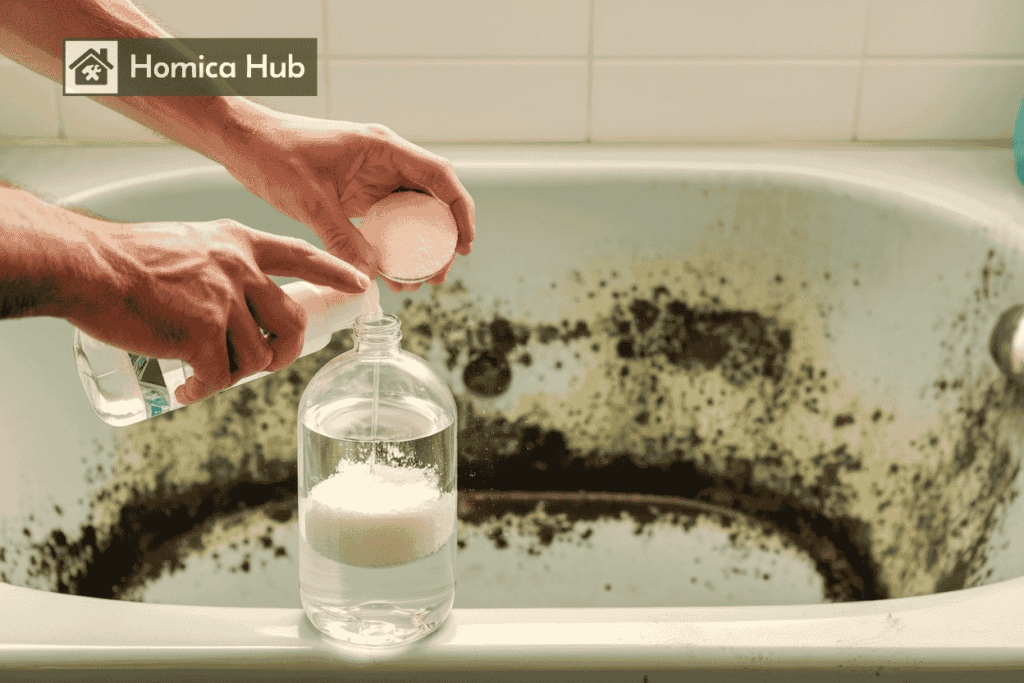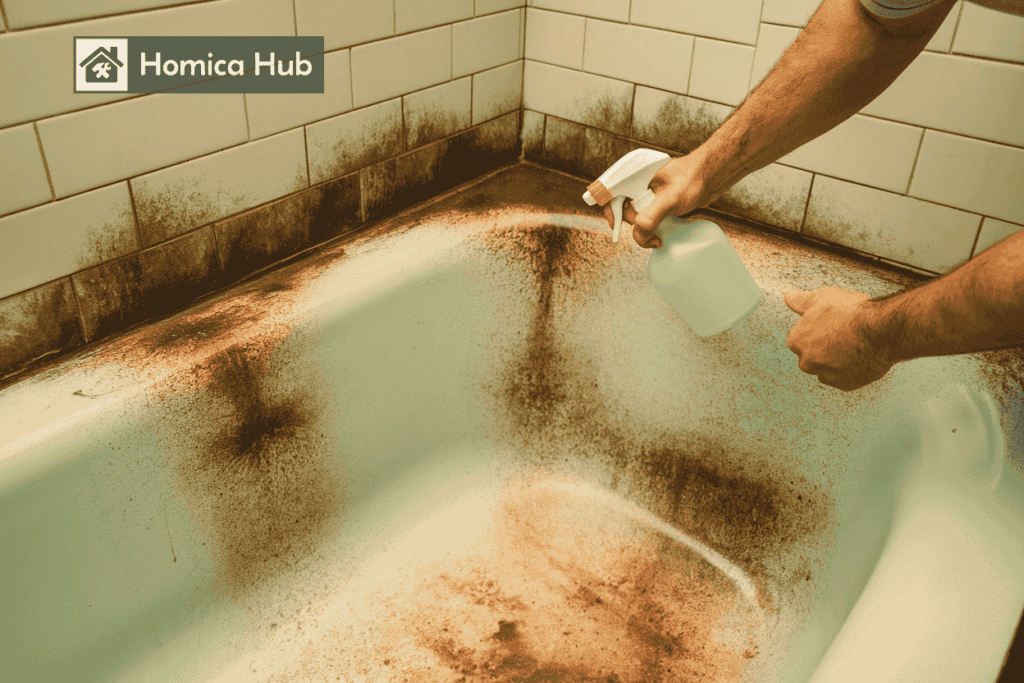There are multiple solutions to get rid of mold in bathtub. It depends on the condition of the mold and how much it sweeps. For a natural solution, spray undiluted vinegar on the mold, let it sit for an hour, then scrub it with baking soda. For more authoritarian mold, apply 3% hydrogen peroxide, wait 10–15 minutes, scrub, and rinse. For severe cases, use a bleach solution (one part bleach, three parts water), let it sit, scrub, and rinse.
1. Vinegar and Baking Soda Cleaning Method

One of the easiest and safest ways to remove mold is with white vinegar and baking soda. Vinegar kills about 82% of mold species, while baking soda works as a gentle abrasive that helps scrub off stains. This method is great for light to moderate mold growth.
Tools and Materials:
- White vinegar (undiluted)
- Baking soda
- Spray bottle
- Scrub brush or sponge
- Warm water
- Dry cloth
Steps to Follow
- Fill a spray bottle with undiluted white vinegar and spray it directly on the moldy areas. Let it sit for at least an hour to break down the mold.
- Sprinkle baking soda over the affected areas and scrub with a brush or sponge. Work in circular motions, focusing on grout lines and corners where mold tends to hide.
- Once the mold is scrubbed away, rinse the area thoroughly with warm water and wipe it dry with a clean cloth to prevent moisture buildup.
"Vinegar kills most types of mold naturally, while baking soda helps remove stains and odors. This method is safe, chemical-free, and effective for mild to moderate mold growth."
2. Hydrogen Peroxide Cleaning Method

If vinegar and baking soda are not enough, hydrogen peroxide is a stronger alternative. It’s a potent antifungal and antibacterial solution that kills mold on contact without the harsh bleach fumes.
Tools and Materials
- 3% Hydrogen Peroxide (Available at most drugstores)
- Spray bottle
- Scrub brush or sponge
- Warm water
- Gloves (Optional but Recommended)
- Clean, Dry Cloth
Steps to Follow
- Wear rubber gloves if you have sensitive skin. Pour 3% hydrogen peroxide into a spray bottle.
- Spray the affected areas generously, soaking the mold thoroughly. Let it sit for 10–15 minutes so the peroxide can penetrate and break the mold.
- Use a scrub brush or sponge to remove the loosened mold, paying extra attention to grout lines and silicone caulking.
- If mold remains, reapply the hydrogen peroxide and let it sit for another 10 minutes before scrubbing again.
- Rinse the bathtub with warm water to remove any remaining mold and peroxide residue, then wipe the surface dry.
"Hydrogen peroxide kills mold on contact and prevents it from growing back. It is a strong antifungal and antibacterial solution that works better than vinegar without harsh fumes."
3. Bleach Cleaning Method for Severe Mold

Bleach is the most potent method for removing mold, especially when dealing with large, stubborn infestations. However, due to its strong fumes, it should be used carefully.
Tools and Materials
- Household bleach
- Water
- Spray bottle
- Scrub brush or sponge
- Gloves and a mask
- Warm water
- Dry cloth
Steps to Follow
- Wear rubber gloves and a mask to protect yourself from bleach fumes.
- In a spray bottle, mix one part bleach with three parts water. Shake the bottle gently to mix.
- Spray the bleach solution directly onto the moldy areas. Let it sit for 10–15 minutes to kill the mold completely.
- Use a scrub brush or sponge to remove the mold. For tough mold spots, reapply bleach and scrub again.
- Rinse the bathtub thoroughly with warm water to remove any bleach residue. Wipe everything dry with a cloth.
"Bleach destroys mold instantly and removes stains, making it the strongest solution. It also prevents mold from coming back when used correctly, but should be handled with caution."
Related Post
How To Get Rid of and Prevent Bathroom Mold
FAQs
Q1: What is the best natural mold remover?
White vinegar is one of the best natural mold removers. It kills about 82% of mold species and works effectively without harsh chemicals. When combined with baking soda, it also removes stains and odors, making it a great all-around solution.
Q2: Can I leave vinegar on mold overnight?
Yes, you can leave vinegar on mold overnight for tougher mold infestations. Letting it sit longer allows it to penetrate deeper and break down stubborn mold. However, ensure proper ventilation in your bathroom to avoid strong vinegar fumes.
Q3: Does vinegar kill 100% of mold?
No, vinegar does not kill 100% of mold species. While it is highly effective against most household molds, some strains may require stronger treatments like hydrogen peroxide or bleach.
Q4: What kills mold better than vinegar?
Hydrogen peroxide and bleach are stronger alternatives to vinegar. Hydrogen peroxide is a safer option, as it kills mold on contact without toxic fumes. Bleach is the most powerful solution, especially for severe infestations, but it should be used with caution due to its harsh chemicals.




[…] A bathtub is one of the most used fixtures in your home, and over time, it can start to look worn out. Chips, stains, and dull finishes can make even the cleanest bathroom feel outdated. But here’s the good news: you don’t need to replace your bathtub to restore its beauty. With a bit of effort, you can renovate your bathtub and give it a fresh, new look, saving both time and money. […]